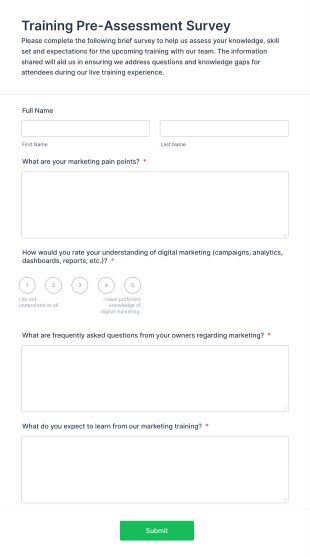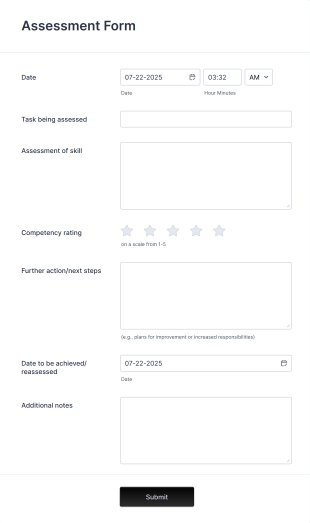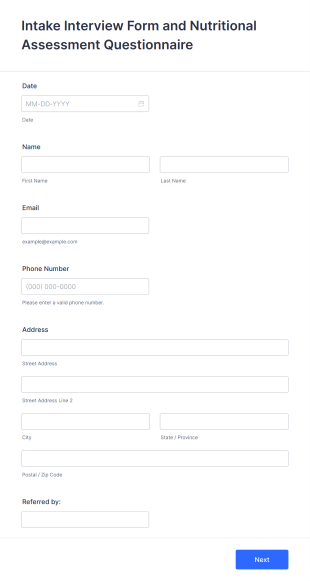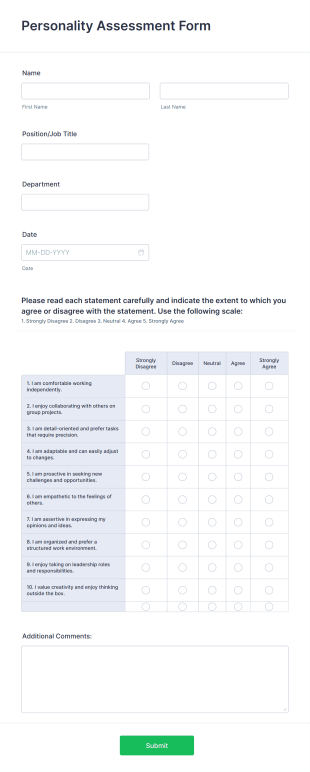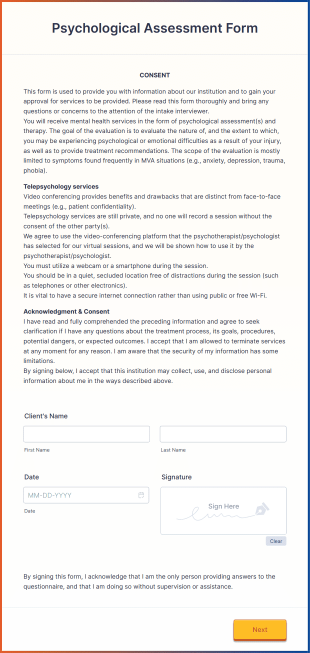Assessment Forms
About Assessment Forms
Assessment Form Templates are pre-designed digital forms used to evaluate, measure, or analyze knowledge, skills, performance, or other criteria across a variety of settings. These templates are commonly utilized in education for student assessments, in the workplace for employee evaluations, in healthcare for patient screenings, and in many other fields where structured feedback or data collection is essential. Assessment forms can range from simple quizzes and self-assessments to complex multi-section evaluations, making them versatile tools for gathering actionable insights and supporting decision-making processes.
With Jotform, users can easily access and customize a wide selection of Assessment Form Templates to fit their unique needs. Leveraging Jotform’s intuitive drag-and-drop Form Builder, users can add or modify questions, integrate scoring logic, and personalize the design to match their branding—all without any coding. Jotform’s platform also supports advanced features such as conditional logic, automated notifications, and seamless data management, ensuring that assessments are not only easy to create but also efficient to distribute and analyze. Whether you’re an educator, HR professional, or healthcare provider, Jotform’s Assessment Form Templates streamline the evaluation process and help you collect reliable data with ease.
Use Cases of Assessment Form Templates
Assessment Form Templates serve a wide range of purposes, making them valuable tools for various industries and professionals. Here’s how they can be used, who benefits from them, and how their creation may differ based on the scenario:
- Possible Use Cases:
1. Educational Assessments: Teachers and trainers use these forms for quizzes, exams, and student feedback.
2. Employee Evaluations: HR departments conduct performance reviews, skills assessments, and 360-degree feedback.
3. Healthcare Screenings: Medical professionals use assessment forms for patient intake, risk assessments, and mental health screenings.
4. Customer Satisfaction: Businesses gather feedback on products or services through structured assessment forms.
5. Self-Assessments: Individuals or organizations use these for self-evaluation, goal tracking, or compliance checks.
- Problem Solving Points:
- Streamlines data collection and analysis.
- Reduces manual paperwork and errors.
- Ensures consistency in evaluation criteria.
- Enables real-time feedback and reporting.
- Possible Owners and Users:
- Educators, school administrators, and trainers.
- HR managers, team leaders, and supervisors.
- Healthcare providers and clinic staff.
- Business owners, customer service teams, and quality assurance managers.
- Individuals seeking personal development or compliance tracking.
- Differences of Creation Methods:
- Educational Assessments: May include multiple-choice, true/false, and open-ended questions, with automated scoring.
- Employee Evaluations: Often feature rating scales, comment sections, and goal-setting fields.
- Healthcare Screenings: Require confidential fields, consent checkboxes, and sometimes conditional logic for follow-up questions.
- Customer Satisfaction: Typically use Likert scales, NPS (Net Promoter Score), and short feedback fields.
In summary, Assessment Form Templates are adaptable to a variety of needs, with content and structure tailored to the specific context and objectives of the assessment.
How to Create an Assessment Form
Creating an effective assessment form with Jotform is a straightforward process that can be tailored to your specific use case, whether you’re evaluating students, employees, patients, or customers. Here’s a step-by-step guide to help you design, customize, and manage your assessment forms efficiently:
1. Start with the Right Template or a Blank Form:
- Log in to your Jotform account and click “Create” on your My Workspace page.
- Choose “Form” and either select from over 10,000 ready-made Assessment Form Templates or start from scratch.
- Pick a layout: Classic Form (all questions on one page) for comprehensive assessments, or Card Form (one question per page) for a guided experience.
2. Customize the Form Content:
- Click on the “Add Element” menu to drag and drop fields relevant to your assessment:
- For educational assessments: Use multiple-choice, short/long text, and file upload fields.
- For employee evaluations: Add rating scales, dropdowns, and comment boxes.
- For healthcare screenings: Include checkboxes, consent fields, and conditional logic for follow-up questions.
- For customer feedback: Use Likert scales, NPS fields, and open-ended feedback sections.
- Use widgets for advanced needs, such as e-signatures or progress bars.
3. Personalize the Design:
- Click the Paint Roller icon to open the Form Designer.
- Adjust colors, fonts, and themes to match your organization’s branding.
- Choose the appropriate layout for your audience and assessment type.
4. Set Up Scoring and Logic:
- Implement conditional logic to show or hide questions based on previous answers.
- Set up automatic scoring for quizzes or self-assessments, if needed.
5. Configure Notifications and Data Management:
- Go to Settings > Emails to set up notification emails for yourself and confirmation emails for respondents.
- Ensure that submissions are automatically stored in Jotform Tables for easy access and analysis.
6. Publish and Share Your Assessment:
- Click “Publish” and copy the form link to share via email, social media, or embed on your website.
- Adjust privacy settings to control who can access and submit the form.
7. Test and Monitor:
- Use the Preview feature to test your form and ensure all logic and scoring work as intended.
- Monitor submissions in real time and use Jotform’s advanced filtering and search tools to analyze results.
By following these steps, you can create a tailored assessment form that meets your specific needs, streamlines data collection, and provides actionable insights for your organization or project.
Frequently Asked Questions
1. What is an assessment form?
An assessment form is a structured tool used to evaluate, measure, or analyze knowledge, skills, performance, or other criteria in various settings such as education, business, or healthcare.
2. Why are assessment forms important?
Assessment forms provide a standardized way to collect and analyze data, ensuring consistency and objectivity in evaluations, which supports better decision-making and continuous improvement.
3. What information is typically included in an assessment form?
Assessment forms may include personal details, multiple-choice or open-ended questions, rating scales, comment sections, and sometimes automated scoring or feedback fields, depending on the purpose.
4. Are there different types of assessment forms?
Yes, assessment forms can vary widely, including educational quizzes, employee performance reviews, healthcare screenings, customer satisfaction surveys, and self-assessment checklists.
5. Who can use assessment form templates?
Educators, HR professionals, healthcare providers, business owners, and individuals can all use assessment form templates to streamline their evaluation processes.
6. How do assessment forms help with data privacy?
Assessment forms created with Jotform can be secured with encryption, password protection, and compliance with privacy regulations like GDPR and HIPAA, ensuring sensitive data is protected.
7. Can assessment forms be customized for specific needs?
Absolutely. Assessment form templates can be fully customized to include specific questions, branding, scoring logic, and more to fit the unique requirements of any organization or scenario.
8. What are the benefits of using digital assessment forms over paper forms?
Digital assessment forms save time, reduce errors, enable instant data analysis, support remote access, and are environmentally friendly compared to traditional paper-based assessments.
